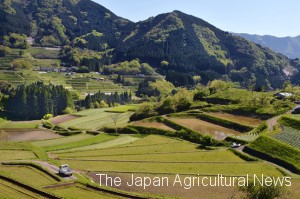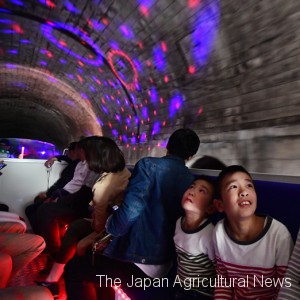
Takachiho Amaterasu Railway’s Grand Super Cart crossing the 105-meter high Takachiho Iron Bridge. (in Takachiho Town, Miyazaki Prefecture)
In Takachiho, Miyazaki Prefecture, a touristic train runs along the tracks of the former Takachiho Railway, which stopped operating in 2008. It’s becoming popular as a train to enjoy the great views of Takachihogo-Shiibayama area, which is one of the World’s Agricultural Heritages in Japan.

Tochimata Tanada Rice Terrace in Takachihogo-Shiibayama region is one of the Globally Important Agricultural Heritage Systems.
The cart will make a round trip between Takachiho Station and the stop beyond the 105-meter high Takachiho Iron Bridge. The cart is named “Grand Super Cart” and has one roofless carriage for 30 passengers and two diesel-powered traction trains on the both ends. The 5.1-kilometer round trip will take approximately 30 minutes.
The train left the station, slowly passed through the fields and forests and then stopped on the bridge for a few minutes. Then the passengers enjoyed the great views of mountains and had fun being freaked out by the view through a look down window, where the floor is made of a transparent tempered glass.
The train runs 10 times a day on everyday except on Thursdays and during the year-end and New Year holidays. Last year, it offered the rides to 24,000 passengers. Yasunori Kouroki is a 62-year-old farmer who grows rice and chestnut in his field near the tracks. “I hope the people who come and visit Takachiho for the train ride will also enjoy agricultural products of Takachiho,” he said.
The train tracks opened in 1972 for local residents. However, the train operation stopped in 2008 due to irreparable damages caused by the devastating typhoon in 2005.
Then a writer from Takachiho, Fumihiko Takayama, established Takachiho Amaterasu Railway to keep the train going on the tracks. In 2009, the company began offering fun rides on human-powered vehicles on the tracks and later introduced engine-powered vehicles. Then in March this year, it welcomed the new Grand Super Cart.
The goal of the new railroad company is resuming the operation of the entire train tracks of approximately 50 kilometers. A 59-year-old train manager, Yoshiharu Sato, said, “We want to contribute to the agritourism of Takachiho, which is recognized as one of the world’s agricultural heritage in Japan.”


